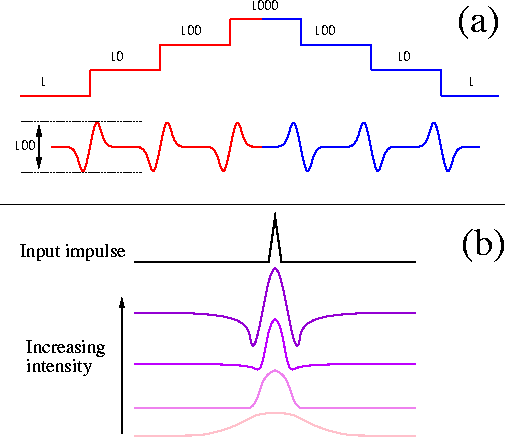



Next: Practical issues in designing
Up: Adaptation
Previous: Light Adaptive Architectures
Adaptation the the light level can be achieved by using spatial
information and removing the redundant parts of the information. In
its simplest and most intuitive form the global spatial average can be
used as the common signal among all detectors. Removing the average
can be performed by using subtraction or division. The dynamic range
will still be limited to a global value. Removing local average
instead of the global average can increase the dynamic range by
several orders of magnitude. The reason being that each region in the
image only adapts to its own average. There has been several models
for spatial adaptation which we will review in this section. One may
find similarities between the response of the systems based on these
models and those from biological retinas. Some of the salient
features of the spatial response of biological retina are(See for
example [Nabet and Pinter 91]):
- Dynamic range reduction: The output signals of the retina have a
much smaller dynamic range than its inputs. Therefore, further
processing stages do not need to cope with large dynamic range.
- Edge enhancement: Edges are very important for every image
processing task. By enhancing the edges further processing stages
will receive more reliable inputs.
- Intensity dependent spatial response: At low light levels, a
biological retina acts as a smoothing filter, and at high
intensities it performs as a spatial band-pass filter. Also as the
light level decreases the span of the spatial processing widens.
These properties have been depicted in
Figure 7.42. Now let us review the models.

Figure 7.42: Properties of the retina. a) the dynamic range reduction and edge
enhancement features. The numbers are just as indicators of the
signal levels. b) Intensity dependent response.
- Subtraction from local average
In this method the local average is subtracted from the signal in
each cell. Sometimes, two local averages with different spatial
distribution are subtracted from each other. This method has two
disadvantages. Firstly, the signal will be centered around
``zero'', and the signal variation will depend on the local average.
For example, if the average current is about 1nA the signal
variation will be around this value. Secondly, this method cannot
reproduce the intensity dependent response. Due to its intuitive
nature this method has been used in many VLSI implementations of the
retina [Mead and Mahowald 88, Bair and Koch 91a, Wu and Chiu 95]. - Division by local average
In this method the signal from one cell is divided by the local
average. One main advantage of this method over subtraction is that
the output is now centered around ``one''. Therefore, the output can
now be normalized to a desired value. In subtraction method, if an
offset (for example 100nA) is added to move the center from
``zero'', small values may get lost. Another advantage of this
method is its multiplicative noise cancellation (MNC) feature. By
dividing the signal to the local average, AC noise from artificial
light source, which reflect from the surface of objects (and hence
have a multiplicative nature), can be reduced to a small fraction.
In fact this method was first introduced for this purpose [Moini et al. 95a, Moini et al. 97b]. It has been used as a pre-processor in
a motion detection chip to reduce the effect of AC light
sources [Moini et al. 97b, Moini et al. 95b].
This method also cannot reproduce the intensity dependent behavior.
- Surface reconstruction from noisy data
This model has originally been developed as a way for reducing the
noise and recovering the signal from noisy data. Using the
regularization theory, one can find the solution to this problem
using the biharmonic equation (See
section 2.6). The VLSI implementation of this
model can produce a normalized output, and demonstrates the dynamic
range improvement and edge enhancement features. Although an
intensity dependence response has been reported using the
implemented circuits, the change of the response is opposite the
change in biological retina, i.e. at higher light levels the spatial
span of the impulse response becomes wider [Boahen and Andreou 92, Andreou and Boahen 94b].
The theoretical model also does not originally account for intensity
dependent characteristics, but it can be modified to include this
feature too.
- Linear lateral inhibition
Linear lateral inhibition is a simple form of lateral inhibition,
where the signal in one cell is subtracted from fractions of the
neighboring cells. This model can demonstrate the edge enhancement
and dynamic range improvement features. However, it still cannot
reproduce the intensity dependent behavior. This method has been
used in the implementation of a few shunting inhibition vision
chips [Wolpert and Micheli-Tzanakou 93]. - Multiplicative lateral inhibition (Shunting inhibition)
In shunting inhibition (SI) a proportion of the output signals of
each cell and its neighbors are subtracted from the signal in each
channel (See sections 2.19 and 3.27).
This model has in fact been developed to model the behavior of the
biological retina. It has demonstrated all properties of the
biological retina. Several vision chips have been designed based on
shunting inhibition [Darling and Dietze 93, Moini et al. 97a].
It is now clear that many VLSI implementations of the retina have
deficiencies, in the context of replicating the function of the
retina; and only shunting inhibition can be regarded as the closest
model for replicating the functionality of the retina.
However, in the context of providing a vision chip which can improve
the dynamic range, enhance the edges, and yet be VLSI friendly the
``division by average'' and the model based on biharmonic equation can
also be considered as viable options.




Next: Practical issues in designing
Up: Adaptation
Previous: Light Adaptive Architectures
Alireza Moini,
Centre for High Performance Integrated Technologies and Systems (CHIPTEC),
Adelaide, SA 5005,
March 1997

